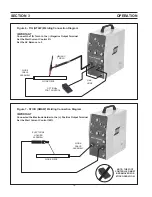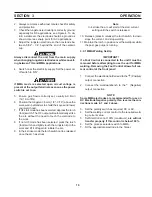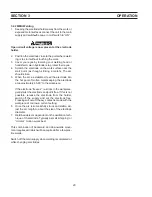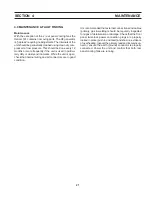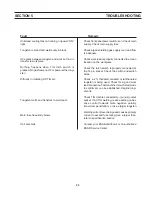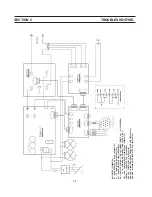
17
SECTION 3
OPERATION
3.0 OPERATION
3.1 Setting Up for TIG Welding
1. Connect the Heliarc TIG torch power lead to the -
(negative) output receptacle.
2. Connect the Heliarc TIG torch gas hose to the front
panel gas outlet.
3. Connect a remote control (trigger switch or foot con-
trol) to the 14 way remote control socket.
4. Connect the work cable to the + (positive) output
receptacle.
5. Connect the gas inlet hose to the Argon regulator
flowmeter, turn-on the cylinder valve and set the .
6. Check the TIG torch is correctly assembled and the
tungsten tip is properly prepared, see later section.
Use 2% thoriated tungstens for DC TIG welding and
1% zirconiated for AC. Recommended tungsten di-
ameters are as follows:
DC--- 2% thoriated, 2% Ceriated or 1.5% Lanthanated
10 - 70A
1.6mm (1/16”)
50 - 160A
2.4mm (3/32”)
AC--- 1 % zirconiated, 2% Ceriated or Thoriated,
1.5% Lanthanated
25 - 55A
1.6mm (1/16”) (#3 - Balance Setting)
90 - 160A
2.4mm (3/32”) (#10 - Balance Setting)
Note: When AC TIG welding, turning the balance control
clockwise, to give greater cleaning, increases the
heat in the tungsten and hence reduces its maxi-
mum current capacity. More melting or rounding
or the tungsten will also be seen.
3.2 TIG Welding
1. Set the front panel controls as required:
-2 or 4 stroke, HF or touch start TIG mode
(4 Stroke inoperative if Foot Control is used)
-AC or DC process
-AC balance if AC TIG welding (3 is a good starting
point)
-Start current
-Main current
-Slope down time (If a remote current control is
used set to minimum)
-Gas post flow time
IMPORTANT!
If a remote current control device is connected, eg
the FC-5B foot control, the remote device will con-
trol the weld current from minumum to the maximum
current setting on the front panel weld current con-
trol knob. If the knob is set to 80 amps, the maxi-
mum current of the remote device will be 80 amps.
The start current setting is a percentage of the weld
current setting.
Figure 4 - Proper Electrode Grinding
STABLE ARC
Pointed Tip
Straight Ground
Flat Tip
9
8
Radial Ground
5/32”-1/4” (4-7mm)
Electrode
Stickout
ARC WANDER
Figure 5 - Proper Electrode Stickout
Summary of Contents for Heliarc 161
Page 4: ...4 TABLE OF CONTENTS ...
Page 22: ...22 SECTION 4 MAINTENANCE ...
Page 26: ...26 SECTION 6 REPLACEMENT PARTS 12 9 3 4 15 5 17 18 16 8 14 13 6 7 11 10 19 20 ...
Page 28: ...28 SECTION 6 REPLACEMENT PARTS ...
Page 29: ...29 Notes ...
Page 30: ...30 Notes ...
















